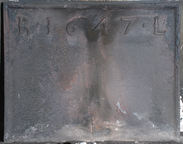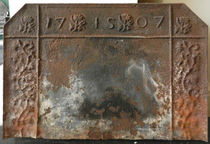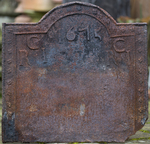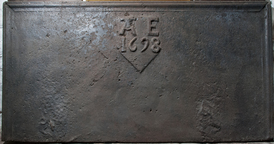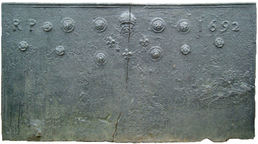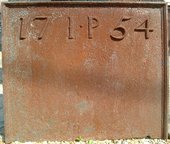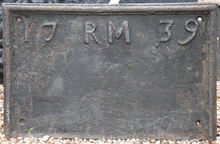-
514
Description: Rectangular; ovolo-moulded edging (top and sides); inscription along top of plate.
Notes: The initials may relate to Robert, 2nd Earl of Leicester.
Inscription: R · 1647 · L
- Decoration tags:
- rectangular (shape)
- ovolo (edging)
- individual letters
- individual numbers
- text
Manufactured: in 1647 in the Weald area of England.
Current location: Penshurst Place, Penshurst, Kent, England.
- Attached to series:
- Date & initials firebacks
-
517
Description: Rectangular; ogee within broad fillet moulded edging; top centre, date between split initials, with small diamonds between date and initials and outside initials.
Inscription: T 1665 S
- Decoration tags:
- rectangular (shape)
- fillet and ogee (edging)
- text
Manufactured: in 1665 in the Weald area of England.
Current location: Penshurst Place, Penshurst, Kent, England.
- Attached to series:
- Date & initials firebacks
-
910
Description: Canted rectangle; cavetto-moulded edging (top and sides); single horizontal fillet below canted corners and vertical fillet parallel to each side, dividing the fireback into two side panels, two top corner panels, top panel and main central panel; corner panels, ‘daisy’ plant stamp; top panel, central initials between split date, separated by 'daisy' stamps; side panels, swirling foliage stamp repeated each side, initial at bottom of panel: I to the left, B to the right.
Notes: The 'daisy' stamp and the IB initials are found on other backs in a distinct series. The foliage stamp is not known on other backs in the series. Christie's Interiors - Masters & Makers (Sale 5462), South Kensington, London, 8 July 2014, lot 126 (£688).
Inscription: 17 IS 07 / I B
- Decoration tags:
- rectangular with canted top corners (shape)
- cavetto (edging)
- carved stamps
- individual letters
- individual numbers
- text
- plants
Manufactured: in 1707 in the Forest of Dean area of England.
Current location: not known.
- Attached to series:
- IB series
- Date & initials firebacks
-
978
Description: Arched rectangular shape; twisted rope edging with inaccurately parallel arched rectangular fillet inside, enclosing repeated small fleur-de-lys stamps along sides and top; initials in triad in each of the internal top corners; date in arch.
Notes: The initials probably relate to a couple whose surname begins with C, the husband's forename initial being R and the wife's I (or J).
Inscription: RCI/ 1675 / RCI
- Decoration tags:
- rectangular with round arch (shape)
- rope (edging)
- simple stamps
- carved stamps
- individual letters
- individual numbers
- heraldic
- text
Manufactured: in 1675 in England.
Current location: not known.
- Attached to series:
- Date & initials firebacks
-
1096
Description: Rectangular shape; ogee/cyma reversa moulded edging (top and sides); top centre, shield-shaped stamp bearing initials above date.
Notes: Two blemishes on the surface of the casting indicate that the molten iron was probably poured from two ladles simultaneously disturbing the casting sand in both locations.
Inscription: AE / 1698
- Decoration tags:
- rectangular (shape)
- cyma reversa/ogee (edging)
- carved stamps
- date stamp
- heraldic
- text
Manufactured: in 1698 in the Weald area of England.
Current location: The Manor House, Mark Cross Lane, Ripe, East Sussex, England.
- Attached to series:
- Date & initials firebacks
-
601
Description: Rectangular; astragal and fillet moulding on top and side edges; symmetrical layout of date and initials; date split between left and right sides, initials in middle, central letter in line with date, outer letters lower.
Notes: One of a series of backs dating to the 1730s and 40s using very similar sets of letters and numerals. K may relate to the surname, while the F and S may relate to the initials of husband and wife respectively. Sold at Christie's Masters and Maker auction, 30 November 2010, lot 521 (£1000 part with no. 623, no. 634 and no. 637). Mander Auctioneers, Sudbury, Suffolk, 2 Dec 2023, lot 455 (ns); 20 Jan 2024, lot 289 (£30 part).
Inscription: 17 K 38 / F S
- Decoration tags:
- rectangular (shape)
- astragal & fillet (edging)
- individual letters
- individual numbers
- planklines
- text
Manufactured: in 1738 in the Weald area of England.
Current location: not known.
- Attached to series:
- Date & initials firebacks
- 1730s-40s, date & initial series
-
611
Description: Rectangular; twisted rope edging (top and sides) with fillet inside; top centre, rose-and-crown between four concentric roundels, two on each side in line, with two more below the inner ones; small fleurs-de-lys in triad below rose-and-crown; top left, initials; top right, date; small rose below date; triad of small roses to right of, and below, initials.
Notes: The style of rose and crown is similar to that used in gun founding in the Tudor period, suggesting that the furnace that was the source of this fireback may have been used for that purpose. Sold at Christie's Masters and Makers auction, 30 November 2010, lot 524 (£688).
Inscription: RP 1692
- Decoration tags:
- rectangular (shape)
- rope (edging)
- carved stamps
- heraldic
- royal
- text
- objects
Manufactured: in 1692 in the Weald area of England.
Current location: in private hands, Wadhurst, East Sussex, England.
- Attached to series:
- 1660s-90s Wealden series
- Date & initials firebacks
-
618
Description: Canted rectangle; twisted rope edging (top and sides); top centre, initials in triad between split date.
Notes: A late date for a very simple design.
Copies of this fireback are known.
Inscription: 17 T M M 48
- Decoration tags:
- rectangular with canted top corners (shape)
- rope (edging)
- individual letters
- individual numbers
- text
Manufactured: in 1748 possibly in the Weald area of England.
Current location: Mark Ripley Forge & Fireplaces, Northbridge Street, Robertsbridge, East Sussex, England.
- Attached to series:
- Date & initials firebacks
-
623
Description: Rectangular; ovolo moulded edging (top and sides); at top, date split by initials (with dot between).
Notes: A bold, elegant plate with characters in high relief. The character set is known to have been used for another fireback cast at Heathfield Furnace, Sussex. Sold at Christie's Masters and Makers auction, 30 November 2010, lot 521 (£1000 part with no. 601, no. 637 and no. 634).
Inscription: 17 I·P 54
- Decoration tags:
- rectangular (shape)
- ovolo (edging)
- individual numbers
- text
Manufactured: in 1754 at Heathfield Furnace in the Weald area of England.
Current location: not known.
- Attached to series:
- Date & initials firebacks
- 1750s Heathfield series
-
634
Description: Rectangular; astragal and fillet moulding on top and side edges; symmetrical layout of date and initials; date split between left and right sides, initials in middle.
Notes: One of a series of backs dating to the 1730s and 40s using very similar sets of letters and numerals. Sold at Christie's Masters and Makers auction, 30 November 2010, lot 521 (£1000 part lot with no. 601, no. 623 and no. 637).
Inscription: 17 RM 39
- Decoration tags:
- rectangular (shape)
- astragal & fillet (edging)
- individual letters
- individual numbers
- text
Manufactured: in 1739 in the Weald area of England.
Current location: not known.
- Attached to series:
- Date & initials firebacks
- 1730s-40s, date & initial series
